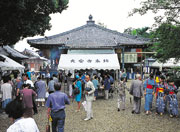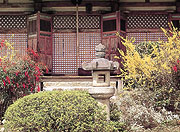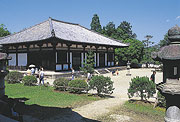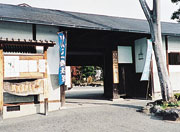 |
 |
 Founded
in the 8th century, Daianji Temple was named with the hope
of bringing peace and happiness to the world. It was then
a gigantic, solemn temple comparable to Todaiji Temple. The
ruin sites of the large pagodas to the east and west remind
us of the era when the temple flourished, about 1300 years
ago. The temple contains rare Buddhist statues in the style
known as "Daianji-yoshiki". Founded
in the 8th century, Daianji Temple was named with the hope
of bringing peace and happiness to the world. It was then
a gigantic, solemn temple comparable to Todaiji Temple. The
ruin sites of the large pagodas to the east and west remind
us of the era when the temple flourished, about 1300 years
ago. The temple contains rare Buddhist statues in the style
known as "Daianji-yoshiki".
 0742-61-6312
/ 9:00 - 17:00 / Open 7 days a week 0742-61-6312
/ 9:00 - 17:00 / Open 7 days a week
  400 400
 Take
bus No. 81, 131, 132 or 133 from JR or Kintetsu Nara Station
and get off at Daianji. A 10-minute walk from the bus stop Take
bus No. 81, 131, 132 or 133 from JR or Kintetsu Nara Station
and get off at Daianji. A 10-minute walk from the bus stop |
 |
 |
 |

Hokkeji Temple, Kairyuoji Temple and Futaiji
Temple |
 |
| National treasure
buildings in the sanctuaries designated as world heritage
sites |
|
 |
 |
 Hokkeji
Temple was once the head temple of the nunneries built throughout
Japan during the 8th century. Kairyuoji Temple, located to
the east of Hokkeji Temple, was established to pray for the
safe voyage of "Kentoshi" or a group of delegates dispatched
from Japan to Tang Dynasty China for studies. Even today,
the temple is often visited by students to and from abroad.
Futaiji Temple was said to have been originally established
to worship a Buddhist statue carved by Ariwara-no-Narihira,
a famous poet of the 9th century. Hokkeji
Temple was once the head temple of the nunneries built throughout
Japan during the 8th century. Kairyuoji Temple, located to
the east of Hokkeji Temple, was established to pray for the
safe voyage of "Kentoshi" or a group of delegates dispatched
from Japan to Tang Dynasty China for studies. Even today,
the temple is often visited by students to and from abroad.
Futaiji Temple was said to have been originally established
to worship a Buddhist statue carved by Ariwara-no-Narihira,
a famous poet of the 9th century.
Hokkeji Temple
 0742-33-2261
/ 9:00 - 16:00 (Mar. to Sept.: 9:00 - 16:30) 0742-33-2261
/ 9:00 - 16:00 (Mar. to Sept.: 9:00 - 16:30)
  500 500
 Take
bus No.12,13,131 or 140 from JR or Kintetsu Nara Station and
get off at Hokkeji Mae. Take
bus No.12,13,131 or 140 from JR or Kintetsu Nara Station and
get off at Hokkeji Mae.
Kairyuoji Temple
 0742-33-5765
/ 9:00 - 16:30 0742-33-5765
/ 9:00 - 16:30
  400 400
 Take
bus No.12,13,131 or 140 from JR or Kintetsu Nara Station and
get off at Hokkeji Mae. Take
bus No.12,13,131 or 140 from JR or Kintetsu Nara Station and
get off at Hokkeji Mae.
Futaiji Temple
 0742-22-5278
/ 9:00 - 17:00 / Open 7 days a week 0742-22-5278
/ 9:00 - 17:00 / Open 7 days a week
  400 400
 Take
bus No. 12, 13, 131 or 140 from JR or Kintetsu Nara Station
and get off at Futaijiguchi. A 5-minute walk from the bus
stop Take
bus No. 12, 13, 131 or 140 from JR or Kintetsu Nara Station
and get off at Futaijiguchi. A 5-minute walk from the bus
stop |
 |
 |
| The 'Standing Statue
of Gigeiten', Muse in the Orient |
|
 |
 Located
to the northwest corner of the Nara Heijokyo palace, Akishinodera
Temple was established in the Nara Period (8th century). The
Temple is famous for its "Standing Statue of Gigeiten" or
Goddess of Luck. This elegant standing figure is extremely
beautiful and is designated as an important cultural asset
of Japan. Within the sanctuary, especially in fall when the
Japanese bush clover is in full bloom, it is possible to feel
the traditional beauty of Japanese seasons. Located
to the northwest corner of the Nara Heijokyo palace, Akishinodera
Temple was established in the Nara Period (8th century). The
Temple is famous for its "Standing Statue of Gigeiten" or
Goddess of Luck. This elegant standing figure is extremely
beautiful and is designated as an important cultural asset
of Japan. Within the sanctuary, especially in fall when the
Japanese bush clover is in full bloom, it is possible to feel
the traditional beauty of Japanese seasons.
 0742-45-4600
/ 9:30 - 16:30 / Open 7 days a week 0742-45-4600
/ 9:30 - 16:30 / Open 7 days a week
  500 500
 Take
bus No. 72 from Kintetsu Yamato Saidaiji Station and get off
at Akishinodera. Take
bus No. 72 from Kintetsu Yamato Saidaiji Station and get off
at Akishinodera. |
 |
| See traditional
craftsmanship |
|
 |
 Young
artisans of traditional Nara arts and crafts show their traditional
craft skills. The products produced here are displayed and
sold on site. The workshops of six artisans are open to visitors
for observation, including "Ittobori" wooden sculptures, "Akahadayaki"
pottery, lacquer ware, mounting, 'Tonbodama' glass beads,
and 'Kogakumen' ancient masks. Next to the Nagaya is the Nara
Ink Museum where visitors are able to see how carbon-based
ink bars are produced (October to April). The experience of
traditional ink making is available for a small charge.
Experience Program : Nigirizumi (Making an ink bar by hand) Young
artisans of traditional Nara arts and crafts show their traditional
craft skills. The products produced here are displayed and
sold on site. The workshops of six artisans are open to visitors
for observation, including "Ittobori" wooden sculptures, "Akahadayaki"
pottery, lacquer ware, mounting, 'Tonbodama' glass beads,
and 'Kogakumen' ancient masks. Next to the Nagaya is the Nara
Ink Museum where visitors are able to see how carbon-based
ink bars are produced (October to April). The experience of
traditional ink making is available for a small charge.
Experience Program : Nigirizumi (Making an ink bar by hand)
 0742-41-7011
/ 10:00 - 17:00 / Closed on Mondays (or the next Tuesday if
the Monday falls on a national holiday) 0742-41-7011
/ 10:00 - 17:00 / Closed on Mondays (or the next Tuesday if
the Monday falls on a national holiday)
  500 500
 A
3-minute walk from Kintetsu Nishinokyo Station A
3-minute walk from Kintetsu Nishinokyo Station |
|

